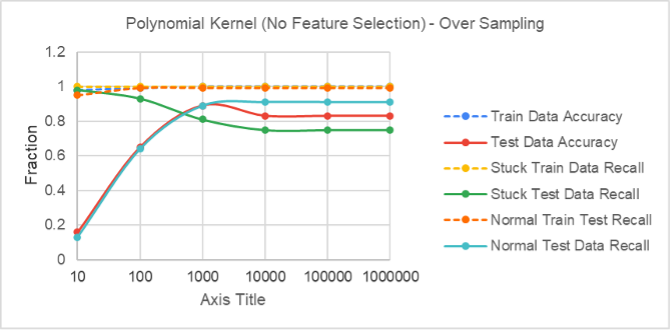Stuck Pipe Detection in Geothermal Operation with Support Vector Machine
Abstract
One of the biggest problems during drilling operation is a stuck pipe in which the drill string would stick or freeze in the well. This challenge leads to a significant amount of remedial costs and time. Many researchers have investigated different factors regarding the stuck pipe. These factors include poor hole cleaning, improper mud design, key seating, balling up of bit, accumulation of cutting and caving, poor bottom hole assembly configuration, and differential pressure. Since geothermal drilling targets lost circulation zones at reservoir depth, the chance of getting stuck pipe events becomes higher. Many publications reported that lost circulation events that lead to stuck pipe events have become the top non-productive time (NPT) contributor to costs in many geothermal drilling projects. The consequences of a stuck pipe are very costly, that include lost time when releasing the pipe, time, and cost of fishing out the parted Bottom Hole Assembly (BHA), and efforts to abandon the tool(s) in the hole. Despite many observations that have been done to develop a system in avoiding stuck pipe incidents in oil and gas drilling operations using artificial intelligence (AI), few works have been developed for geothermal drilling operations. In this research, we propose a method to build an early warning system model for stuck pipe conditions based on a Support Vector Machine. Based on the experiment result Support Vector Machine Algorithm showed good performance with 89% accuracy and 81% recall for limited training dataset.
Full text article
References
Afifah, Lutfia. 2021. “Apa Itu Confusion Matrix Di Machine Learning?”
Alshaikh, Abrar, Arturo Magana-Mora, Salem Al Gharbi, and Abdullah Al-Yami. 2019. “Machine Learning for Detecting Stuck Pipe Incidents: Data Analytics and Models Evaluation.” P. D021S021R003 in Day 2 Wed, March 27, 2019. Beijing, China: IPTC.
Anon. 2021. “Apa Pengaruh C Dalam SVM Dengan Kernel Linear?” Retrieved October 15, 2021 (https://qastack.id/stats/31066/what-is-the-influence-of-c-in-svms-with-linear-kernel).
Anon. 2021. “Normalisasi Data Dengan Python Scikit-Learn.”
Arnaout, Arghad, Bilal Alsallakh, Rudolf Fruhwirth, Gerhard Thonhauser, Bilal Esmael, and Michael Prohaska. 2012. “Diagnosing Drilling Problems Using Visual Analytics of Sensors Measurements.” Pp. 1750–53 in 2012 IEEE International Instrumentation and Measurement Technology Conference Proceedings.
Bishop, Christopher M. 2006. Pattern Recognition and Machine Learning. New York: Springer.
Bradley, W. B., D. Jarman, R. S. Plott, R. D. Wood, T. R. Schofield, R. A. Auflick, and D. Cocking. 1991. “A Task Force Approach to Reducing Stuck Pipe Costs.” OnePetro.
Campesato, Oswald. 2020. Python 3 for Machine Learning. Dulles, Virginia: Mercury Learning and Information.
Chamkalani, Ali, Mojtaba Pordel Shahri, and Saeed Poordad. 2013. “Support Vector Machine Model: A New Methodology for Stuck Pipe Prediction.” P. SPE-164003-MS in All Days. Muscat, Oman: SPE.
Geothermal communities. 2021.“Geothermal Class Chapter 2,” July 12.
Geothermal communities. 2021.“Geothermal Class Chapter 9,” July 12.
Huawei. 2021. “Huawei AI Academy.”
Johansson, Robert. 2019. Numerical Python: Scientific Computing and Data Science Applications with Numpy, SciPy and Matplotlib. Berkeley, CA: Apress.
Kirby, Cliff, Andreas Sadlier, Christopher Wood, and Morten Vinther. 2013. “Filling the Experience Gap in the Drilling Optimization Continuous Improvement Cycle through a Self-Learning Expert System.” P. SPE-164365-MS in All Days. Manama, Bahrain: SPE.
Mohajon, Joydwip. 2021. “Confusion Matrix for Your Multi-Class Machine Learning Model.”
Murillo, Adriana, Johanna Neuman, and Robello Samuel. 2009. “Pipe Sticking Prediction and Avoidance Using Adaptive Fuzzy Logic Modeling.” OnePetro.
Purba, Dorman, Daniel W. Adityatama, Febri N. Siregar, Muhamad Solehudin, M. Rizqi Al Asy’ari, Artahsasta Adi Wicaksana, Mukhamad F. Umam, Dicky Alamsyah, Ribka Asokawaty, and Enerka Bhumi Pratama. 2021. “Integrated Stuck-Pipe-Prevention Campaign in Geothermal Drilling Project in Indonesia: A Proactive Approach.” Wordl Geothermal Congress 11.
Russell, Stuart J., and Peter Norvig. 2022. Artificial Intelligence: A Modern Approach. Fourth edition, global edition. Harlow: Pearson.
Salminen, Kent, Curtis Cheatham, Mark Smith, and Khaydar Valiullin. 2017. “Stuck-Pipe Prediction by Use of Automated Real-Time Modeling and Data Analysis.” SPE Drilling & Completion 32(03):184–93. doi: 10.2118/178888-PA.
Siruvuri, C., Halliburton Digital, Consulting Solutions, S. Nagarakanti, Nabors Industries, R. Samuel, Halliburton Digital, and Consulting Solutions. 2006. “Stuck Pipe Prediction and Avoidance: A Convolutional Neural Network Approach.” SPE Drilling & Completion 6.
Sperber, Axel, Inga Moeck, and Wulf Brandt. 2010. “Drilling into Geothermal Reservoirs.” Pp. 113–71 in Geothermal Energy Systems, edited by E. Huenges. Weinheim, Germany: Wiley-VCH Verlag GmbH & Co. KGaA.
Starmer, Josh. 2021. Machine Learning in StatQuest.
Suykens, J. A. K., L. Lukas, and J. Vandewalle. 2000. “Sparse Least Squares Support Vector Machine Classi Ers.” 6.
Vapnik, Vladimir N. 2000. The Nature of Statistical Learning Theory. New York, NY: Springer New York.
Wintjen, Marc. 2020. Practical Data Analysis Using Jupyter Notebook.
Xue, Qilong. 2020. Data Analytics for Drilling Engineering: Theory, Algorithms, Experiments, Software. Cham: Springer International Publishing.
Yildirim, Soner. 2021. “Hyperparameter Tuning for Support Vector Machines — C and Gamma Parameters.”
Zhu, Qi, Zhaohui Wang, and Jian Huang. 2019. “Stuck Pipe Incidents Prediction Based On Data Analysis.” P. D022S027R001 in Day 2 Tue, October 22, 2019. Dubai, UAE: SPE.
Authors
Copyright (c) 2022 Sarwono Sarwono, Lukas, Maria Angela Kartawidjaja, Raka Sudira Wardana

This work is licensed under a Creative Commons Attribution-ShareAlike 4.0 International License.
This is an open access journal which means that all content is freely available without charge to the user or his/her institution. The copyright in the text of individual articles (including research articles, opinion articles, and abstracts) is the property of their respective authors, subject to a Creative Commons CC-BY-SA licence granted to all others. JEEE allows the author(s) to hold the copyright without restrictions and allows the author to retain publishing rights without restrictions.




